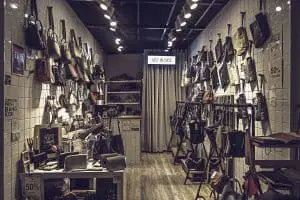Introduction
I have had more than my fair share of unpleasant shopping experiences, mainly stemming from the fit and size of the clothes I was trying on. While it may not seem like it, this frustration can stem from people of all sizes, whether they’re a size 2 or a size 20. However, dissatisfaction during shopping is often skewed towards those whose sizes range in extended size lines. After all, it is a bit of an enigma that the sample size in America is a 2-4 when 67% of American women are a size 14 or above.
Online shopping is another beast in itself when it comes to buying the right size—and if you’re shopping on the site of a brand you’ve never purchased from before? Forget about it. Even though trying on clothes in-store can be a less than positive experience, it seems like the lesser of two evils when compared to blindly ordering a size from a brand online that you have no experience with, as every clothing brand can fit differently.
This is where Universal Standard comes in. Universal Standard is currently the world’s most inclusive fashion brand, but its owners don’t want to stop there. Universal Standard is using an impact-first business model in hopes to revolutionize not only its consumers’ shopping experience but the fashion industry as a whole.
Let’s take a look at the topics we are going to discuss today:
- Universal Standard Origin Story
- What is Impact First?
- Universal Standard Mission
- Implementing The US Mission
- Short Term vs. Long Term Effects
- Conclusions
1. Universal Standard Origin Story
Universal Standard was born from a shopping trip between the two founders, Alexandra Waldman and Polina Veksler. They found themselves in a department store, each having a very different shopping experience. It became apparent to them that there was no true universal standard of shopping, and it is nearly impossible for those women in extended size lines to find any options in most clothing lines.
Thus, Universal Standard was created. Waldman and Veksler sought out to create a brand where women of every body type can have the same carefree shopping experience. They decided in 2015 to create a womenswear line that would not compromise on quality, would fit on every size, and would be comprised of modern essential pieces that would fit in every wardrobe.
The same year, it took only 6 days for their first 8-piece collection to sell out. The next year, the cofounders opened a showroom in NYC and implemented weekly drops instead of seasonal collections. US’s “About Us” page mentions that the duo “saw the first sign that [they] were onto something special with a 1,700-person denim waitlist”. Ever since then, the brand has experienced nothing but growth, thanks to their impact first business model.
2. What is Impact First?
Companies that follow an impact first business model put fighting for a cause at the core of their operations. This might mean that traditional profit-making goals are put second on their priority list and put the purpose of the brand at the forefront.
This business model goes beyond just implementing corporate social responsibility policies in order to appear cause-oriented. A company that follows impact first’s goal is to strike a balance between profit and purpose in its everyday operations. This might mean taking a loss over the first few years of the company in order to ultimately build customer loyalty that will be impossible to replicate by competitors.
3. Universal Standard Mission
As previously mentioned, Universal Standard was created to give women of all shapes the opportunity to have an optimal shopping experience, whether it that is in-store or online. According to the US website, the brand is setting out to change everything about the fashion industry in order for all women to feel seen, and to evolve the definition of beauty. The co-founders are hoping to “create unprecedented access, make size irrelevant… and establish a new normal for future generations”.
Waldman and Veksler want to implement these changes not only in their own brand but call out the rest of the fashion industry to do the same. However, in their own brand, they have six main pillars of values in order to carry out their mission.
4. Implementing The US Mission
The six values that Universal Standard upholds are undoubtedly unique to the brand, which has led it to be the most inclusive brand in the world. Waldman and Veksler are not hoping that they remain this way, although. They hope that brands will see their tactics and adopt the same values as they have in order to be a part of the change in the fashion industry.
- Revolutionary Inclusivity: This value is what sparked the creation of Universal Standard, and what has grown the brand into what it is today. The US website emphasizes “erasing the line between ‘us’ and ‘them’” in the world of fashion. To do so, the brand carries the largest range of sizes in a single womenswear line, from size 00 to size 40. Another way Universal Standard provides an inclusive shopping experience is how its website allows shoppers to see what any clothing item looks on every size, from 00 to 40. Traditionally, online websites will only use models of one size (usually the smallest) and have consumers try to picture what the item will look like on their own body. The US has eliminated this frustration from the online shopping experience, and many brands have been following in their footsteps.
- Quality Defined: Universal Standard ensures that all customers’ shopping experiences are elevated by providing merchandise with only premium fabrics in their merchandise. Some of these fabrics include Peruvian cotton, Italian Merino wool, and French satin. The brand only uses the best materials in the production of their items so that the pieces will last for years after purchase.
- Advanced Engineering: The Universal Standard site emphasizes the importance of not fitting into your clothes, but your clothes fitting you. The company does so by engineering its items to different size models. No formulas or pre-set numbers are used in the making of their clothes—instead, they use different size models throughout the production process to ensure that each item fits and drapes on each body type in the right and most flattering way. This is an added bonus, considering US merchandise is essentials that will rarely go out of style.
- Fit Liberty: Universal Standard wants its customers to know that it is completely normal for bodies to change over time. To do so, it offers a line in which customers can send back their items if they change size at all and have them replaced for free for a year after purchase. This offer allows women to not worry about what number size they are, but instead be in tune with their body and wear clothes that make them feel comfortable and confident.
- Do Good, Give Back: While it is obvious that Universal Standard gives back to its customers, the company looks to build a stronger community as well. The US participates in various charity events each year, like their own Denim Drive or in a partnership with Dress for Success to empower women entering the workforce. US works with their Fit Liberty line to help give back to women in communities all over the country.
- Customer-Centric, Always: As we have seen previously, Universal Standard as a brand completely revolves around the customer. Its goal is “to consistently elevate—and ultimately exceed—your expectations”. This is why, the website explains, that their collections drop weekly instead of seasonally, and why they encourage customers to reach out to a customer service representative with any problem or need that may arise. No problem is too big or too small for the customer service department of the US.
5. Short Term vs. Long Term Effects
Because Universal Standard has adopted a business model that follows the characteristics of impact first, it means that fighting for a purpose is at the top of the priority list. This also means that profit-making falls to second place. Universal Standard isn’t cutting any corners when it comes to fighting to address inclusivity issues in the fashion industry. They are manufacturing high-quality merchandise in the largest range of sizes in the world. This means that the US is choosing both quantity and quantity when it comes to their lines. Using so many high-quality resources does not happen at a cheap price tag. In the first few years of the company, a lot of money was probably dedicated to carrying out this business model at an operational level, that it was hard to generate a true profit.
The short-term consequences of an impact first business model are often outweighed by the long-term gains. Once an impact first brand has been established for a few years, it builds a reputation among consumers that cannot be replicated by competitors. Universal Standard’s business model has allowed them to become the most inclusive womenswear line in the world-a title that cannot be shared by any competitor. The US is also reaching the broadest audience imaginable by appealing to women of truly all sizes and creating a common experience for all of them.
What is even more unique about Universal Standard, however, is that the founders hope that other brands do try to replicate their sustainable competitive advantage efforts. They didn’t want to create this brand for their own good, but truly for the greater good. The US hopes that their impact will be large enough to change the course of the fashion industry, and eliminate the anxiety, pressure, and fear that come along with the notion of “size” in fashion.
6. Conclusions
Having a difficult time finding the correct size can be a universal experience, although it is much harder for women of “extended” sizes to ultimately find multiple options when looking for trendy clothes to fill their closets. (And, I say “extended” because as mentioned previously, the average size of a woman in America is 16-18, but plus-size in the US is considered to be a size 14.)
Thus, Universal Standard was born, a clothing brand started by two friends whose goal was to have the most inclusive fashion line in the world, and they have done just that. Not only have they achieved their main goal, but they have challenged the fashion industry as a whole to change their ways and hopefully one day, eliminate the need for a numerical size on clothing.
To follow through with this mission, the US has followed an impact first business model, where the company puts fighting for a cause first and focuses on the profit-making second. Instead of just trying to appear cause-oriented in the public eye, impact first businesses incorporate their cause at an operational level. This model attempts to strike a balance between profit and purpose.
Universal Standard has built fighting for body positivity and inclusion into their brand by highlighting six main values. First, “revolutionary inclusivity” influenced their product range to be the widest in the world, from 00 to 40. Second, “quality defined” is reached by using only premium materials in their merchandise. “Advanced engineering” is how each product is made—not with formulas, but with real body types to ensure correct fit. Next, the US prides itself on promoting “fit liberty” by carrying a line of essentials that can be returned and exchanged up to a year if your size fluctuates. The US founders also incorporated the value of “do good, give back” by working with charities in their fit liberty. Lastly, the value “customer-centric, always” is what holds the US to a standard of customizing the shopping experience around their customers
An impact first business model is not traditional and can come with drawbacks. It is apparent that Universal Standard is not cutting any corners when it comes to providing a comfortable shopping experience for its customers. With the wide range of sizes and premium materials used in their merchandise, building this brand was not cheap. In the first years of operation, US likely took a loss in profits. However, now, the brand has built loyalty with consumers that resonate with the cause they are fighting for. This loyalty cannot be copied by any other brand, which is what makes Universal Standard profitable in the long run, regardless of monetary profits.







